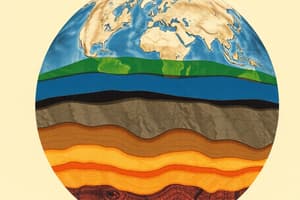Podcast
Questions and Answers
What is the approximate temperature at the Earth's core?
What is the approximate temperature at the Earth's core?
- 5,000°C to 6,000°C (correct)
- 7,000°C to 8,000°C
- 3,000°C to 4,000°C
- 9,000°C to 10,000°C
What is the main component of the Earth's inner core?
What is the main component of the Earth's inner core?
- Sulfur (~85%)
- Liquid iron (~85%)
- Iron (~85%) (correct)
- Nickel (~85%)
What is the role of the Earth's core in plate tectonics?
What is the role of the Earth's core in plate tectonics?
- It helps slow down the process of convection in the Earth's mantle.
- It helps drive the process of convection in the Earth's mantle. (correct)
- It has no effect on the process of convection in the Earth's mantle.
- It stops the process of convection in the Earth's mantle.
What is the approximate radius of the Earth's outer core?
What is the approximate radius of the Earth's outer core?
What is the purpose of the Earth's core?
What is the purpose of the Earth's core?
What is the approximate pressure at the Earth's core?
What is the approximate pressure at the Earth's core?
Which empire's fragmentation led to the emergence of new kingdoms in the 10th-11th centuries?
Which empire's fragmentation led to the emergence of new kingdoms in the 10th-11th centuries?
Who became King of England in 927 and unified the kingdom?
Who became King of England in 927 and unified the kingdom?
Which dynasty ruled France for over 300 years?
Which dynasty ruled France for over 300 years?
What was established in England after the Norman Conquest of 1066?
What was established in England after the Norman Conquest of 1066?
Which of the following was a characteristic of the new kingdoms that emerged in medieval Europe?
Which of the following was a characteristic of the new kingdoms that emerged in medieval Europe?
In which region did the kingdoms of Poland, Hungary, and Bohemia emerge in the 10th-11th centuries?
In which region did the kingdoms of Poland, Hungary, and Bohemia emerge in the 10th-11th centuries?
Flashcards are hidden until you start studying
Study Notes
Earth's Core
Composition
- The Earth's core is divided into two layers: the solid inner core and the liquid outer core
- The inner core is composed of:
- Iron (~85%)
- Nickel (~10%)
- Sulfur (~5%)
- The outer core is composed of:
- Liquid iron (~85%)
- Liquid nickel (~10%)
- Liquid sulfur (~5%)
Temperature and Pressure
- The temperature at the Earth's core is estimated to be around 5,000°C to 6,000°C (9,000°F to 11,000°F)
- The pressure at the core is immense, reaching over 3.5 million times the pressure at sea level
Size and Shape
- The inner core has a radius of approximately 1,220 km (758 miles)
- The outer core has a radius of approximately 2,250 km (1,400 miles)
- The core makes up about 1/5 of the Earth's volume
Function
- The Earth's core is responsible for generating the planet's magnetic field
- The movement of molten iron in the outer core creates electric currents, which in turn generate the magnetic field
- The core also plays a crucial role in plate tectonics, as it helps drive the process of convection in the Earth's mantle
Earth's Core
Composition
- The Earth's core consists of two layers: solid inner core and liquid outer core.
- Inner core is composed of 85% iron, 10% nickel, and 5% sulfur.
- Outer core is composed of 85% liquid iron, 10% liquid nickel, and 5% liquid sulfur.
Temperature and Pressure
- The core temperature is estimated to be around 5,000°C to 6,000°C (9,000°F to 11,000°F).
- The pressure at the core is immense, reaching over 3.5 million times the pressure at sea level.
Size and Shape
- The inner core has a radius of approximately 1,220 km (758 miles).
- The outer core has a radius of approximately 2,250 km (1,400 miles).
- The core makes up about 1/5 of the Earth's volume.
Function
- The Earth's core generates the planet's magnetic field.
- The movement of molten iron in the outer core creates electric currents, generating the magnetic field.
- The core plays a crucial role in plate tectonics, driving the process of convection in the Earth's mantle.
New Kingdoms in Medieval History
The Rise of New Kingdoms
- Carolingian Empire's fragmentation during the 10th-11th centuries leads to the emergence of new kingdoms, including England, France, and Germany.
Kingdom of England
- 927: Athelstan unifies the Kingdom of England.
- 1016: Canute the Great, a Danish king, conquers England.
- 1066: William the Conqueror leads the Norman Conquest of England, establishing a feudal system and Norman nobility.
Kingdom of France
- 987: Hugh Capet, Count of Paris, becomes King of France, establishing the Capetian dynasty.
- The Capetian dynasty rules France for over 300 years.
- 11th-12th centuries: The French monarchy consolidates power and territory.
Kingdom of Germany
- 919: Henry the Fowler, Duke of Saxony, becomes King of Germany.
- 936: Otto I, Holy Roman Emperor, establishes the German kingdom.
- 10th-11th centuries: The German monarchy competes with the papacy for power and influence.
Other Kingdoms
- 10th-11th centuries: Kingdoms of Poland, Hungary, and Bohemia emerge in Eastern Europe.
- 11th-12th centuries: Kingdoms of Sicily, Naples, and Portugal arise in Southern Europe.
- 11th-12th centuries: Kingdoms of Scotland, Wales, and Ireland develop in the British Isles.
Characteristics of New Kingdoms
- Decentralization of power and feudalization of society.
- Emergence of nobility and aristocracy.
- Development of chivalry and knightly culture.
- Growth of trade and commerce.
- Increased importance of cities and towns.
Studying That Suits You
Use AI to generate personalized quizzes and flashcards to suit your learning preferences.




